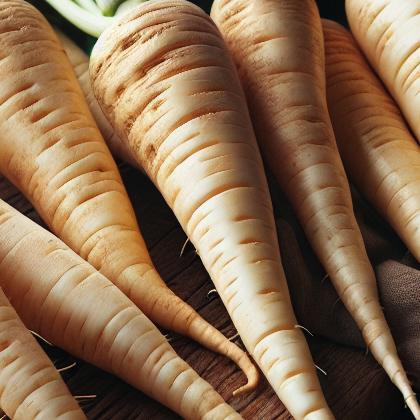Parsnips

The parsnip (Pastinaca sativa) is a root vegetable closely related to the carrot and parsley. It is a biennial plant usually grown as an annual. Its long tuberous root has cream-colored skin and flesh and can be left in the ground when mature as it becomes sweeter in flavor after winter frosts. In its first growing season, the plant has a rosette of pinnate, mid-green leaves. If unharvested, it produces its flowering stem, topped by an umbel of small yellow flowers, in its second growing season. By this time the stem is woody and the tuber inedible. The seeds are pale brown, flat and winged.The parsnip is native to Eurasia. It has been used as a vegetable since antiquity and was cultivated by the Romans, although there is some confusion in the literature of the time between parsnips and carrots. It was used as a sweetener before the arrival in Europe of cane sugar. It was introduced into the United States in the nineteenth century.The parsnip is usually cooked but can also be eaten raw. It is high in vitamins and minerals, especially potassium. It also contains antioxidants and both soluble and insoluble dietary fiber. It can be cultivated in deep, stone-free soils and is attacked by the carrot fly and other insect pests, viruses and fungal diseases, of which canker is the most serious. In sunlight, handling the stems and foliage can cause a skin rash.

Parsnips Properties:
| Food Property | Type | Description |
|---|---|---|
| Flavor Profile | Sweet | Parsnips have a naturally sweet flavor, similar to carrots. |
| Bitter | Parsnips may have a slight bitter undertone, especially when cooked for a longer period. | |
| Texture | Firmness | Parsnips have a firm texture when raw, but become tender when cooked. |
| Moisture | Parsnips have a high moisture content, making them juicy and succulent when cooked. | |
| Nutritional Value | Macronutrients | Parsnips are rich in carbohydrates and dietary fiber, providing energy and promoting digestive health. |
| Micronutrients | Parsnips are a good source of vitamins and minerals, such as vitamin C, potassium, and folate. | |
| Fiber | Parsnips contain a significant amount of dietary fiber, which can aid in digestion and support overall gut health. | |
| Color | Natural Pigments | Parsnips have a creamy white or pale yellow color, due to the presence of natural pigments in the root vegetable. |
| Aroma | Volatile Compounds | Parsnips have a slightly sweet and earthy aroma, especially when cooked. |
Food Pairing App - Version 1.2.0
